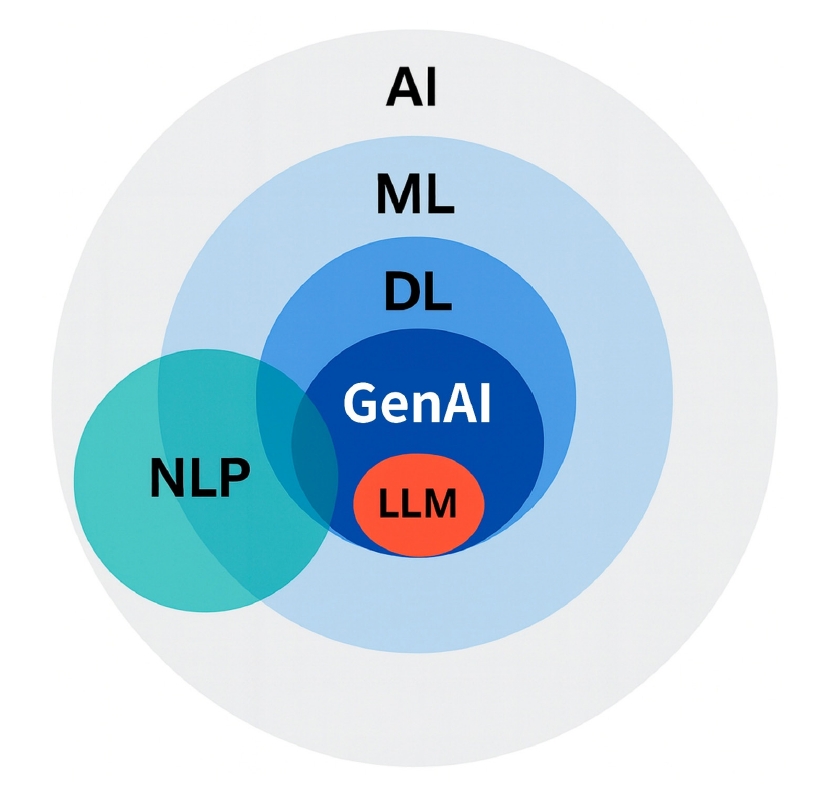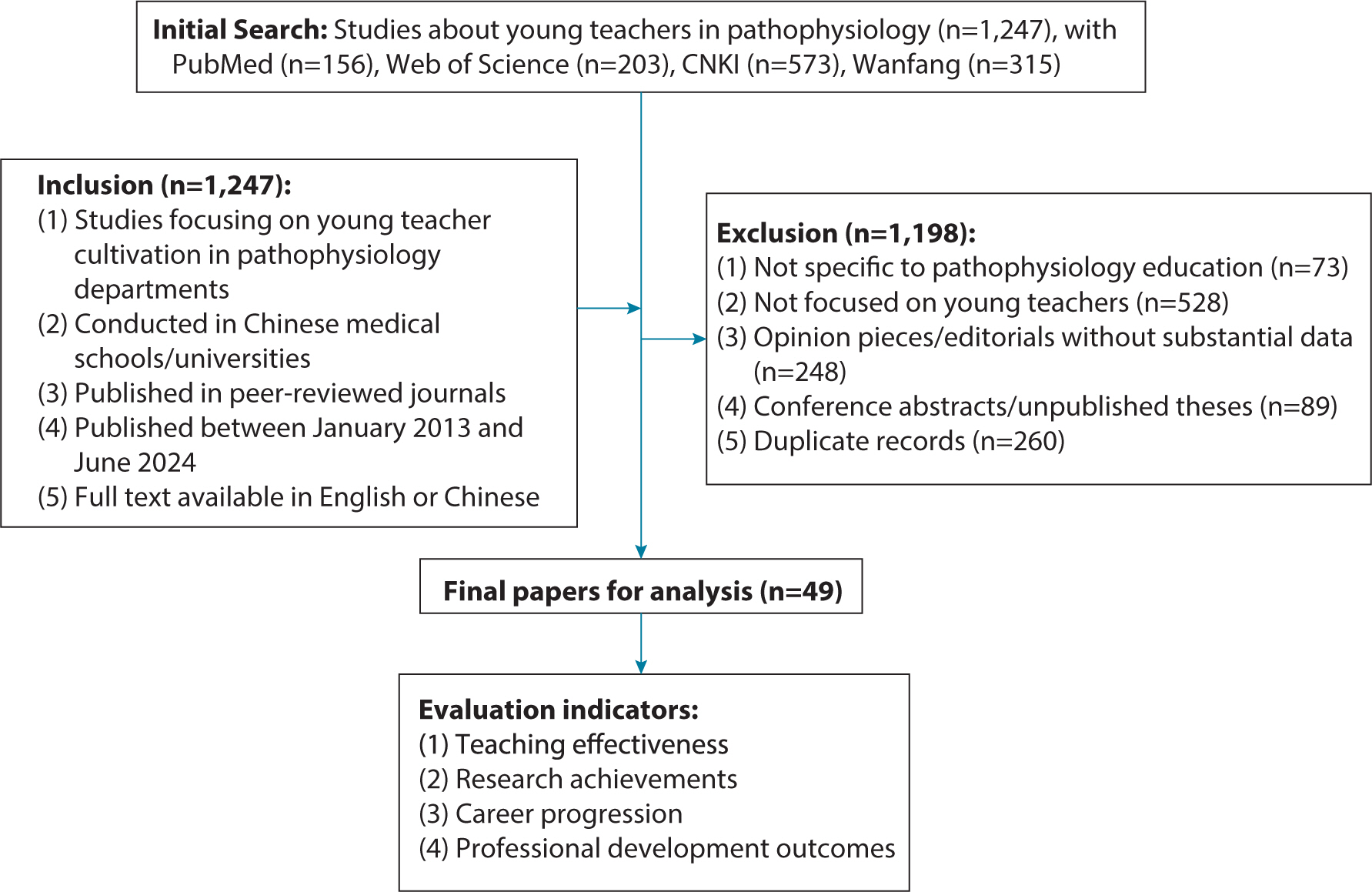
 , Jihyun Ahn
, Jihyun Ahn

This narrative review examines the challenges, strategies, and future directions in the development of young teachers within the pathophysiology departments of Chinese medical colleges. A thorough review of 49 studies published between 2013 and 2024 was carried out using PubMed, Web of Science, and various Chinese databases. The primary challenges identified include teaching innovation (cited in 84.2% of the studies), research pressure (91.2%), disciplinary characteristics (87.7%), and career development (80.7%). Medical schools have responded by enhancing training systems (94.7%), innovating teaching methods (93.0%), and bolstering research support (96.5%). Looking ahead, trends are shifting toward the application of new technologies, interdisciplinary integration, and international collaboration. The focus on cultivating young teachers is increasingly geared towards personalization and diversification, which are essential for advancing education in pathophysiology. High-quality young teachers are pivotal in raising teaching standards, fostering research innovation, and facilitating interdisciplinary exchanges. Based on these insights, we recommend several practical measures to enhance the quality of pathophysiology education in China. These include establishing comprehensive training programs that integrate teaching innovation and research skills; developing structured mentorship systems with clear pathways for career advancement; creating platforms that support technology-enhanced teaching and international collaboration; and implementing systematic evaluation mechanisms to assess teaching effectiveness. These targeted interventions will require a coordinated effort from department heads, educational institutions, and policymakers to ensure a sustained improvement in the quality of pathophysiology education.
 , Kyunghee Jung-Choi
, Kyunghee Jung-Choi , Bo Young Kim
, Bo Young Kim , Kyoung Ae Kong
, Kyoung Ae Kong
This study aimed to investigate the prevalence of unhealthy dietary habits by maternal educational level and how the effect of maternal education changed between 2009 and 2019.
Using data from the Korea Youth Risk Behavior Survey conducted between 2009 and 2019, we assessed the prevalence of each unhealthy dietary habit (insufficient consumption of milk and fruit/vegetable, breakfast-skipping, and frequent consumption of fast food, soft drinks, and instant noodles) and the prevalence difference between maternal middle/high school and college graduate groups in four periods. The models included maternal educational level, four periods and the interaction between them, sex, and grade. In addition, we estimated the ORs of unhealthy dietary habits between the two maternal educational groups at each period.
Throughout the study period, unhealthy dietary habits were consistently more prevalent among mothers with lower education levels. Between 2009–2010 and 2017–2019, the prevalence of unhealthy dietary habits increased, with a particular increase in that of frequent consumption of fast food and soft drink. The prevalence differentials between the middle school and college graduate group decreased or did not differ, while those between the high school and college graduate groups increased over time. A similar trend was observed in the relative scale.
Considering the increase in the prevalence of unhealthy dietary habits and the prevalence differentials by maternal educational level, targeted efforts are needed not only for all adolescents and their parents but also for those with low socioeconomic status to improve the dietary habits of adolescents.
 , Hwa Young Lee
, Hwa Young Lee , Young Mi Park
, Young Mi Park , Hee Jung Yi
, Hee Jung Yi
A Womans University College of Medicine faces curriculum reform in 2020. To determine what reforms are needed in the premedical curriculum, a needs assessment was conducted.
This study utilizes qualitative study method. A focus group interview was conducted with four students who completed premedical courses from November to December 2018. Interviews were conducted in two groups by grade level, and each interview was recorded. After transcribing the recorded contents, four researchers analyzed the data using conventional content analysis.
Students chose A Womans University College of Medicine considering their future careers as female medical professionals and other considerations such as scholarships. The students expected diverse experiences, exchanges with students in different departments, and fusion of medicine with other fields during their premedical years. Overall, these expectations were met during the course, but individual needs for customized education, such as liberal arts, were unmet. In general, students' attitudes toward premedical courses were very motivated and they actively used resources provided by the university.
Qualitative research can provide a better understanding of quantitative data, such as a student survey performed to prepare for curriculum reform. Based on this understanding, the curriculum will be reformed to reflect the educational needs of students, to motivate students and to provide satisfactory education.
Citations

 , Jung-A Shin
, Jung-A Shin
There is a growing trend of medical students using electronic devices for studying. This paper analyzes such trend and assesses if the utilization of devices is adequate to effectively help students to study.
Survey of total 155 medical students about the usage of the electronic devices for studying during the first year of medical school was done. The answers were matched with their exam scores in the first year.
Most of students were using a device, as a learning tool and the most important purpose of it was its convenience, especially for taking notes during lectures. However, students who didn't use a device when they learned anatomy or who studied with the printouts showed a tendency of receiving better scores on exams.
Utilizing electronic devices for studying tends to be more convenient, but not effective for studying anatomy.

In order to examine the issue of women and health in Korean society, we need to adopt a new approach to consider health and body as a subject of social theory beyond the biomedical model. Health and diseases are not objective entities defined by universal standards that are separate from the patient or physician's life experience, but rather the products of social, cultural, and political processes. From this point of view, this paper explores Korean women and health in two aspects of health and medical field, that is, women as medical service beneficiaries and providers. First, the gender paradox phenomenon—women live longer, but suffer from more illnesses—was confirmed by evaluating the physical and mental health status of women. The life expectancy of Korean women is longer, but their morbidity rate of physical and mental health and subjective health evaluation is worse than men. Second, as medical service providers, the present status of female doctors showed the horizontal and vertical segregation in the medical labor market despite of the increase of female doctors and medical students. We pointed out the problems of gender inequality in health care sector and discuss policy implications of ‘gender specific medicine’ to improve women's health and medical education.

Critical care medicine is to provide advanced medical care to critically ill-patients threatened by severe diseases. Although critical care is a core area of surgery, surgeons have fewer interests and opportunities for participating in it, and the dedicated intensivists with other specialties have had a deeper involvement. It is difficult to recruit surgical intensivists or trauma surgeons for critical care due to the high labor intensity, high risk of medical accidents and conflicts, and inappropriate remuneration. The most common cause, however, is the lack of opportunities for surgical cases. There is a negative perception among surgeons that surgical intensivists are ‘the surgeons who do not operate.’ That makes the surgeons feel the gap between what they majored and what they practice. Acute care surgery, that is a relatively new, but more specialized surgical area including emergency surgery, trauma and critical care, can be a good alternative. Critically ill-patients who suffered from hemorrhagic shock, septic shock, acute renal injury, and acute respiratory distress syndrome need the intensive and aggressive treatments. Surgeons have been used to these invasive and aggressive procedures. Surgeons who have trained the critical care may be able to acquire the expertise, easily. The intensivists as a surgeon, who fully understands the operations, postoperative courses or complications, or the optimal time of surgery, can provide more efficient and accurate treatments for surgically critically ill-patients than any intensivists with other specialties. It is needed to change the surgeons' negative perceptions themselves with the support of the Korean Society of Surgery.
Citations


There are several problems which hamper the successful teaching of writing in medical education. To deal with these problems, teachers should be conscious of two general questions; what to teach in writing class for premedical students; and how to utilize the
This paper reviews a subject in premedical education,
Students accomplished the learning objectives and they recognized the value of peer assessment and feedback.
Peer assessment and peer feedback foster students' participation in class and accelerate the learning process. This strategy reminds students of the fact that they are writing an essay for an audience.
 , Jae Jin Han
, Jae Jin Han , Claire Junga Kim
, Claire Junga Kim , Hee Jung Choi
, Hee Jung Choi , Joo Chun Yoon
, Joo Chun Yoon , Hye-Kyung Jung
, Hye-Kyung Jung , Han Su Kim
, Han Su Kim
This paper aims to describe an outcome-based curriculum development process at a medical school that has difficulty in advancement from the higher stage outcomes to the individual lesson outcomes, and to propose a way to implement it practically.
We reviewed the objectives, strategies and previous products of the school's taskforce activities and suggested the principle of bidirectional approaches of outcome based curriculum development.
The developing strategy identified such as firstly, the evaluation of present curriculum and then, the review of the outcomes developed previously with considering the nation-wide environmental change in medical education. Then, we selected one example course which was focused the resources of the school to, and finally the product of the example course was propagated to the other courses with central monitoring.
Bidirectional model of ‘Top-down’ plus ‘Bottom-up’ approaches could be an efficient way to develop the outcome-based curriculum in a medical school, which has difficulties to advance the developing process due to various reasons including limited resources.
Citations


Since mid-20th century, many environmental changes in medicine have challenged the traditional role of doctors and the movement to outcome-based education (OBE) has progressed gradually but significantly. Over decades bilateral progression of defining the global doctor's role and developing OBE with implementation to medical schools has been spread world-widely. In this paper, we explored the history and contents of the doctor's role and OBE at various levels-international, national, institutional and medical schools. We conclude that the global doctor's role is composed of patient care, communication and professionals added by others related to their peculiar situation and should be linked to the outcomes of undergraduate, postgraduate and continuous medical education which are developed and implemented to the curriculum and program at any country in order to cope with the global challenges of the future.
Citations

 , Do-Sang Cho
, Do-Sang Cho , Soon Sup Chung
, Soon Sup Chung , Hye-Sook Park
, Hye-Sook Park , Hoo Jae Hann
, Hoo Jae Hann
This study was performed to provide information on the relationship between admission criteria and medical school performance (MSP). Seventy six medical students admitted to the Ewha School of Medicine in 2007 were enrolled. The admission criteria included the undergraduate grade point average (GPA), medical education eligibility test (MEET), essay, letters of recommendation, and admission interview score. MSP was measured by GPA. Standard tests of bivariate correlation and multivariate regression analysis were used to examine the relationship between multiple factors of admission criteria and MSP for the first two years after admission. Among the admission criteria, scores of undergraduate GPA, essay, and letters of recommendation were significantly correlated with MSP. Admission interview score, however, had no correlation with MSP. Although total MEET score was not related with MSP as well, science reasoning-2 demonstrated significant correlation with MSP. Further studies will be needed to define the clear relationship between various admission criteria and MSP.
 , Kristi J Ferguson
, Kristi J Ferguson
Comparing with the traditional curriculum which provides mainly basic medical science training in the first 2 years, the early exposure to clinical medicine is a major trend of medical education through recent decades. However the timing, extent, content and methods of the 'early clinical education' are not defined clearly and the application is various. Preparing the transformation of the curriculum from undergraduate to graduate entry at Ewha medical school, the concepts of 'early clinical exposure' into our new curriculum needs to be clear. We want to decide how early and how deep and what contents of clinical knowledge and skills are to be introduced in the new curriculum.
Literature review. Interview with a developer and the participants of the 'early clinical education' curricula which has been applied in the Carver College of Medicine, University of lowa since 1998.
The early exposure of clinical knowledge and skills has been introduced world widely and many curricula have it as early as the very week of entrance. Problem based learning, standardized patient program, clinical skill labs and clinical mentoring, etc. are being used with various modification. Early clinical education enhanced the loaming interest and professional minds to the medical students as well as their achievements.
The early clinical education will be applied to the new curriculum of the graduate school of medicine starting 2007 in Ewha Medical School.

